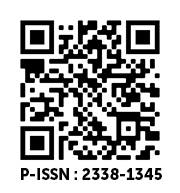Response of Fonio (Digitaria exilis) Accessions to Fertilizer Application
DOI:
https://doi.org/10.36782/apjsafe.v10i2.146Keywords:
Fonio; Accessions; Savannah agro-ecology; Morphological traits; GhanaAbstract
Fonio is one of the lost crops of Africa, and part of the reasons it has been neglected is inadequate information on Fonio growth and yield potential across its growing areas, hence the need to assess the response of available germplasm to fertilizer application. The objectives of the study were to determine the growth and yield response of Fonio accessions to fertilizer application, and to evaluate the interactive effect of fertilizer and Fonio accession on growth and yield. The study was conducted in Northern Ghana, during the 2019 cropping season. The research used a 4 x 5 (four fertilizer levels and five accessions) factorial experiment in a randomized complete block design with three replications. The finding showed that growth and yield parameters were significantly (P< 0.05) affected by fertilizer application. The result also revealed that accession OUSAI recorded the highest grain yield of 1015.10 kg/ha and NFAS4 recorded the least grain yield of 713.23 kg/ha. Also, the most lodged accession was OUAS1 which recorded 65% lodging of its total plant population and the least lodged accessions (NFAS4 and EYAS5) recorded about 10% lodging each. There was significant (P ˂ 0.05) variations among accessions for most of the attributes measured. The interactive effect of fertilizer and accession was significant ((P˂0.05) for most of the traits studied.
Downloads
References
Annegers, J.F. 1973. Ecology of Dietary Patterns and Nutritional Status in West Africa. 1. Distribution of Starchy Staples. Ecology of Food and Nutrition 2: 107–119.
Ashley D.A., Doss B.D. and Bennett 0.L., 1963. A method of determining leaf area in cotton. Agronomy Journal 55: 584- 585.
Chapman, G.P. and Peat, W.E. 1992. An Introduction to the Grasses (Including Bamboo and Cereals). CAB International, Wallingford, UK.
Clottey, V.A., Agyare, W.A., Bayorbor, T.B., Abanga, J.J. and Kombiok, J.M. 2006. Genetic relatedness of fonio (Digitaria spp.) landraces assembled in Ghana. Pl Genet Resources News l 147, 6-11.
Cruz, J.F. 2004. Fonio: a small grain with potential. In: magazine on LEISA. Vol. 201, March 2004, 16-17.
Cruz, J.F., Béavogui, F. and Djibril Dramé. 2011. Fonio an African Cereal, By Edition Que,CTA, Presses agronomiques de Gembloux, collection Agricultures tropicales enpoche. DOI: 10.5897/JPBCS2016.0605.
Dachi, S.N. and Gana, A.S. 2008. Adaptability and yield evaluation of some Acha (Digitaria exilis and Digitaria iburua Kippis Stapf) accessions at Kusogi – Bida, Niger State, Nigeria. African Journal of General Agriculture 4, No. 2, Pp 73-77.
Dalziel, J.M. 1937. The Useful Plants of West Tropical Africa. Crown Agents, London, UK., 525–526, 1937.
Danladi, D.K., Emmanuel, K.N., Stephen, D., Mark, U. and Emmanuel, D.I. 2003. Potential role of biotechnology tools for genetic improvement of lost crops of Africa: the case of fonio (Digitaria exilis and Digitaria iburua). African Journal of Biotechnology 2(12): 580–585.
Hilu, K.W.M., Ribu, K., Liang, H. and Mandelbaum, C. 1997. Fonio millets: Ethnobotany, South Africa Journal Biotechnology 63 (4): 185-190.
Ibrahim Bio Yerima, A. R., Achigan-Dako, E.G., Aissata, M., Sekloka, E., Billot, C., Adje, C.O.A., Barnaud, A. and Bakasso, Y. 2020. Agromorphological characterization revealed three phenotypic groups in a region-wide germplasm of fonio (Digitaria exilis (Kippist) Stapf) from West Africa. Agronomy Journal 10(11). https:perperdoi.orgper10.3390peragronomy10111653.
Jideani, I.A., Owusu, R.K. and Muller, H.G. 1994. Proteins of Acha (Digitaria exilis Stapf): Solubility Fractionation, Gel Filtration and Electrophoresis of Protein Fractions. Food Chemistry 51: 51–59.
Morales-Pay’an, J.P., Ortiz., J.R., Cicero, J. and Taveras, F. 2002. Digitaria exilis as a crop in the Dominican Republic Supplement to: Trends in new crops and new uses. J. Janick and A. Whipkey (eds.) ASHS press, Alexandra, V.A.
NRC. 1996. Lost Crops of Africa, vol. 1: Grains. National Research Council. National Academy Press, Washington DC, USA. Pages 59–75.
Okeme, S., Omale, P.I. and Gwamis, A.A. 2017. Acha (Digitaria spp) Production and utilization in Africa: the way forward. International Journal of Agricultural and Veterinary Sciences 3(2): 16–25.
Oppong-Anane, K. 2006. Country pasture and forage resources profiles: Ghana. Food and Agriculture Organization of the United Nations (FAO) HTTP: perperwww.fao.orgperagper AGPperAGPCper docperCounprofper PDF% 20filesperGhana- English.pdf (retrieved June, 2020).
Priyadarshani, N.D.N., Amarasinghe, M.K.T.K., Subasinghe, S., Palihakkara, I.R. and Kumarasinghe, H.K.M., 2000. Effect of Organic and Inorganic Fertilizers on Biomass. The Journal of Agricultural Sciences, 8(1): 28–35.
Vodouhè, S.R., Achigan Dako, E., Dansi, A. and Adoukonou-Sagbadja, H. 2003. Fonio: A treasure for West Africa. Poster, International workshop on Underutilized Plant Species. Leipzig, Germany, 6-8 May 2003.
Vodouhe` R.S., Dako, G.E.A. and Dansi, A., 2004. Fonio: a treasure for West Africa. Plant genetic resources and food security in West and Central Africa. Ibadan, Nigeria, 219–222.
Wrigley, G. (1981). “Tropical Agriculture: The Development of Production”. CTA-Longman, London, UK. pp. 150–165.
Wood, T.N., 2013. Digital Commons and University of Nebraska - Lincoln Agricultural Development in the Northern Savannah of Ghana. Available at https:perperdigitalcommons.unl.eduperplanthealthdocPart. Retrieved 5TH December 2019 at 19:00 GMT.









